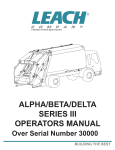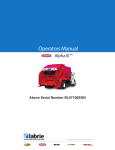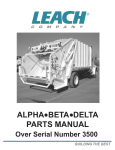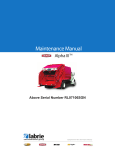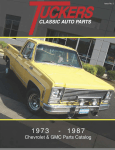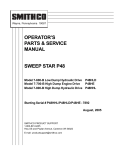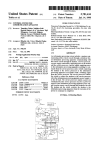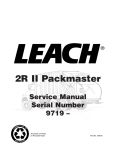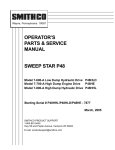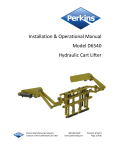Download 2RII Operators Manual Over Serial Number 16000
Transcript
2RII PACKMASTER OPERATORS MANUAL Over Serial Number 16000 BUILDING THE BEST WARRANTY Refuse bodies manufactured by Leach Company, (“Company”) are supplied and sold under a Limited Warranty that they are and will remain free of defects in workmanship or material for a period of six (6) months from the date of original sale under reasonable conditions of use and operation, providing required planned maintenance services are performed. Extended warranty packages are available for purchase. If a failure occurs during said period because of such defect in the opinion of the Company, the component or part shall be repaired or replaced by an authorized Leach Distributor at no cost to the customer provided the unit is brought to the distributor’s service facility. After three (3) months, performance of adjustments or the replacement of wear/expendable components is not covered under warranty. This limited warranty is the sole and exclusive warranty of the Leach Company. THE COMPANY MAKES NO WARRANTY AS TO MERCHANTABILITY, FITNESS FOR USE, LEGALITY OF OPERATION IN ANY JURISDICTION OR ANY IMPLIED WARRANTY OF ANY KIND OR NATURE. THE COMPANY SHALL NOT BE LIABLE FOR ANY SPECIAL OR CONSEQUENTIAL DAMAGES OF ANY KIND OR NATURE, OTHER THAN ITS LIMITED WARRANTY OF REPLACEMENT HEREIN. NO OTHER PERSON, FIRM, OR CORPORATION CAN BIND THE COMPANY TO ANY WARRANTY OTHER THAN HEREIN ABOVE STATED. To validate the new unit warranty, an authorized Leach Distributor must have completed a predelivery inspection before the unit is placed into service, and the delivery report form signed by both the customer and the distributor must be submitted to the Leach Service Department. Because Company products are engineered to work only with genuine Company parts, this limited warranty will be void and of no effect if: (a) Company products are modified other than as done at its factory or as authorized to be done by the factory in writing; or (b) Parts or assemblies of any other manufacturer are used as substitutes for genuine Company parts. Genuine Leach replacement parts, components and assemblies are also sold under a Limited Warranty to be free from defects in workmanship or material for a period of six (6) months. This is a replacement only warranty and the item must be returned to the Leach distributor for exchange. The labor to replace or repair the part shall be the responsibility of the customer. There is no warranty on expendable items, wear components or used parts. Leach Company reserves the right to redesign and/or discontinue the manufacture of parts, components and assemblies at any time. II FOREWARD Leach Company has been a leader in the refuse industry for over 110 years. Leach refuse bodies are the industry standard for both quality and performance. Leach Company is justifiably proud of the quality engineering, material and workmanship that goes into each and every packer we produce. This commitment to quality extends to the best parts, service and distributor organization in the industry. One area of great importance to us is your safety. This unit was built in accordance with the American National Standards Institute (ANSI) standard for Mobile Refuse Collection and Compaction Equipment-Safety Requirements, ANSI Z245.1-1992. Before operating this unit please read and understand the safety precautions found in Section 2 of this manual. They are important and are provided to assist you in the safe operation of the unit. This manual was produced with the intention of providing clear, concise instructions for the proper operation, maintenance and service of your 2RII refuse packer. It was produced with the latest information available at the time of publication. We do, however, reserve the right to redesign and/or discontinue the manufacture of parts, components or assemblies at any time. Leach Company has an aggressive manual and product improvement program. In any conversation or correspondence dealing with the information provided in any Leach manual please refer to the part number of that manual. The manuals provided with the unit are considered a permanent part of the unit and should be included in the event of a re-sale. Additional manuals are available, free of charge, from your local authorized Leach distributor. These manuals should be kept readily available for easy reference. We ask that if you have comments or suggestions concerning this manual, please contact us at (920) 231-2770. We are here to be of service to you, our valued customer. III TABLE OF CONTENTS WARRANTY . . . . . . . . . . . . . . . . . . . . . . . . . . . . II FOREWORD . . . . . . . . . . . . . . . . . . . . . . . . . . . III TABLE OF CONTENTS . . . . . . . . . . . . . . . . . . IV SECTION 1 – SAFETY PRECAUTIONS General . . . . . . . . . . . . . . . . . . . . . . . . . . . . . . . 1-1 Danger, Warning and Caution Decals . . . . . . . . . 1-1 Prior To Start Up . . . . . . . . . . . . . . . . . . . . . . . . 1-2 Operation . . . . . . . . . . . . . . . . . . . . . . . . . . . . . . 1-3 Hydraulics . . . . . . . . . . . . . . . . . . . . . . . . . . . . . 1-5 Fire Protection . . . . . . . . . . . . . . . . . . . . . . . . . . 1-5 Housekeeping . . . . . . . . . . . . . . . . . . . . . . . . . . 1-5 Shutdown. . . . . . . . . . . . . . . . . . . . . . . . . . . . . . 1-5 Decal Locations . . . . . . . . . . . . . . . . . . . . . . . . . 1-6 SECTION 3 – OPERATION (continued) Loading the Hopper . . . . . . . . . . . . . . . . . . . . . 3-13 Attaching a Container to the Packer . . . . . . . . . 3-13 Using a Winch or Container Lift Cylinder. . . . . . 3-14 Using a Container Push Bar . . . . . . . . . . . . . . . 3-15 Packing the Load . . . . . . . . . . . . . . . . . . . . . . . 3-15 Pushout Panel Operation During Packing Telescopic . . . . . . . . . . . . . . . . . . . . . . . . . 3-16 Disconnecting the Container. . . . . . . . . . . . . . . 3-16 Unloading at Dumpsite . . . . . . . . . . . . . . . . . . . 3-17 Lifting the Tailgate . . . . . . . . . . . . . . . . . . . . . . 3-17 Ejecting the Load . . . . . . . . . . . . . . . . . . . . . . . 3-18 Lowering the Tailgate . . . . . . . . . . . . . . . . . . . . 3-18 Shut Down . . . . . . . . . . . . . . . . . . . . . . . . . . . . 3-19 SECTION 2 – INTRODUCTION Terms You Will Need To Know. . . . . . . . . . . . . . . 2-1 Loading . . . . . . . . . . . . . . . . . . . . . . . . . . . . . . . 2-2 Compaction . . . . . . . . . . . . . . . . . . . . . . . . . . . . 2-2 Unloading. . . . . . . . . . . . . . . . . . . . . . . . . . . . . . 2-3 Container Attachment. . . . . . . . . . . . . . . . . . . . . 2-4 Container Handling Systems . . . . . . . . . . . . . . . 2-4 General . . . . . . . . . . . . . . . . . . . . . . . . . . . . . . . 2-5 Terms You Need to Know . . . . . . . . . . . . . . . . . . 2-5 Hook . . . . . . . . . . . . . . . . . . . . . . . . . . . . . . 2-5 Container . . . . . . . . . . . . . . . . . . . . . . . . . . . 2-5 Container Attachment. . . . . . . . . . . . . . . . . . 2-5 Winch . . . . . . . . . . . . . . . . . . . . . . . . . . . . . 2-6 Container Lifting Cylinder (CLC) . . . . . . . . . . 2-6 Container Push Bar . . . . . . . . . . . . . . . . . . . 2-6 Basic Operation . . . . . . . . . . . . . . . . . . . . . . . . . 2-7 Attach . . . . . . . . . . . . . . . . . . . . . . . . . . . . . 2-7 Dump. . . . . . . . . . . . . . . . . . . . . . . . . . . . . . 2-7 Disconnect . . . . . . . . . . . . . . . . . . . . . . . . . . 2-7 SECTION 3 – OPERATION General . . . . . . . . . . . . . . . . . . . . . . . . . . . . . . . 3-1 Description of Operating Controls . . . . . . . . . . . . 3-1 Location Of Operating Controls . . . . . . . . . . . . . 3-2 Compaction Cycle Operation . . . . . . . . . . . . . . . 3-5 Operating Procedures . . . . . . . . . . . . . . . . . . . . 3-6 Pre-operating Walk-around Inspection . . . . . . . . 3-6 Walk-around Inspection Checklist . . . . . . . . . . . 3-10 Start Up (Operating Instructions) . . . . . . . . . . . 3-11 Positioning Pushout Panel . . . . . . . . . . . . . . . . 3-12 IV SECTION 1 SAFETY PRECAUTIONS GENERAL The 2RII Packmaster has been designed with the operator in mind. However, as with any industrial machinery, especially those that are large and apply forces through hydraulic pressures, the ultimate responsibility for safety rests with you — the user. An alert, conscientious attitude and observance of all known safe operating practices are the best ways to prevent accidents. Publication of these precautions does not imply or in any way represent an all inclusive list. It is the operator’s responsibility to be familiar with and ensure that operation is in accordance with safety requirements and codes including all applicable Occupational Safety & Health Act (OSHA) and American National Standards Institute (ANSI) regulations. Before operating the unit it is the operator’s responsibility to be thoroughly familiar with the instructions contained in the Operator’s Manual. DANGER, WARNING AND CAUTION DECALS See the accompanying illustration for the location and label content of all safety decals. 1. These decals must be obeyed at all times. 2. These decals must be in place at all times. Report any damaged or missing decals to the proper authority at once. 3. Replacement decals can be ordered free of charge from your local authorized Leach distributor. DANGER WARNING AND CAUTION Throughout this manual “DANGER” “WARNING” and “CAUTION” notations accompanied by the International Hazard Symbol are used to alert the operator and mechanics to special instructions concerning a particular operation or service that may be hazardous if performed incorrectly or carelessly. DANGER — Immediate hazards which WILL result in severe personal injury or death. WARNING — Hazards or unsafe practices which COULD result in severe personal injury or death. CAUTION — Hazards or unsafe practices which could result in minor personal injury or property or product damage. Strict compliance to these “safety alerts” combined with “common sense” operations are important accident prevention measures. The word NOTE is also used throughout the manual. It precedes information that provides special emphasis or clarification on a specific operation or procedure. 1-1 SECTION 1 SAFETY PRECAUTIONS PRIOR TO START UP 1. Never operate machinery while wearing jewelry or loose clothing. These items may become caught by or entangled in the machinery causing serious injury. Wear proper safety equipment as required by your employer. 2. Never operate machinery while under the influence of alcohol, narcotics or other mood altering substances. Workers who operate machinery while under the influence are a hazard to themselves and others. 3. Perform a pre-operation “walk around” inspection of the truck chassis in accordance with the chassis manufacturer’s guidelines. Perform a “walk around” inspection of the refuse packer in accordance with the checks listed in Section 3 - Operation of the Operators/Service manual. Never start or operate any equipment found to have malfunctions. a. Report any malfunctions immediately to the proper authorities. b. Prior to leaving any malfunctioning unit the parking brakes must be set, the PTO system disengaged, the engine turned off, the ignition key removed, and using a non-reusable fastening device, place a sign on the steering wheel indicating the unit is inoperative. 4. Proper servicing requires specialized tools and procedures. Service must be performed by authorized personnel only following procedures in the 2RII Service manual. 5. Walk completely around the vehicle to make sure all persons and obstructions are clear before starting the unit. 6. The container handling system is a critical component of the unit, use only the proper replacement parts. 7. Inspect all hooks, chains and cables daily to ensure serviceable condition. Replace damaged or worn parts. (See Section 5, Preventive Maintenance) 8. Before operating the vehicle the driver must be thoroughly familiar with the employer’s safety program concerning traffic rules, warning devices and hand signals. 9. Be sure to know where to get assistance in the event of an emergency. 10. Know your machine. Know the location and function of all controls, gauges, instruments and protective devices. 11. Should the height of a refuse collection vehicle be altered by installing a container handling system, be sure the overall height is rechecked and overall height plus 3 inches is noted on the decals. 1-2 SECTION 1 SAFETY PRECAUTIONS OPERATION GENERAL 1. It is the operator’s responsibility to ensure that operation of the unit is in accordance with the guidelines contained in the Operator’s manual and in accordance with all applicable codes including Occupational Safety and Health Act (OSHA) and American National Standards Institute (ANSI) regulations. vest, protective glasses and protective shoes. 17. All service opening covers and access doors must be maintained and latched in place while operating equipment. 18. Ensure all co-workers are in view before operating or moving any controls or the unit. 19. Ensure that there is sufficient overhead clearance before operating the unit. 3. Move the vehicle as slowly as possible without stalling when traveling in reverse. 20. Ride only in the cab or on riding platforms designed for that purpose. Riding steps shall not be used when speeds are expected to exceed 10 mph or when distance traveled without stopping will exceed 2⁄10 of one mile. Do not mount or dismount riding step when vehicle is in motion. 4. Always make sure the area behind the unit is clear before traveling in reverse. 21. Never allow anyone to ride on the steps when the vehicle is backing up. 5. Do not travel in reverse for distances greater than those dictated by local ordinances. If reverse travel exceeds 10 feet, use a “spotter” or move the vehicle in 10 foot increments only, and then check to make sure the area behind the unit is clear between increments. 22. Stop the vehicle immediately if warning lights for the TAILGATE AJAR system come on. 2. Do not attempt to operate this equipment without proper training. 6. Do not attempt to dislodge any material above waist level unless wearing eye protection such as “approved” side shielded safety glasses or a full face shield. 7. Never use the unit to push or tow another vehicle. 8. Never unload uphill or against a pile of refuse or into the bank of a hill. 9. Never place head, body, fingers or any limbs into a scissors point or pinch point on the equipment. 10. Before operating the vehicle the driver must be thoroughly familiar with the employer’s safety program concerning traffic rules, warning devices and hand signals. 11. Know where to get assistance in the event of an emergency. 12. Know your machine. Know the location and function of all controls, gauges, instruments and protective devices. 13. Wear your seat belt. 14. Start the engine following the manufacturer’s recommended procedure. 15. Always set the parking brake before leaving the cab. 16. Turn on appropriate warning lights, put on a safety 1-3 23. Never use controls or hoses for hand holds when mounting or dismounting. Controls and hoses are movable. They do not provide proper support and may cause accidental equipment movement. 24. Make sure the backup alarm is working properly. 25. Always ensure that all persons are clear before raising or lowering the tailgate. It is the operator's responsibility to warn all persons not to stand or cross under a raised tailgate. 26. Do not move the vehicle with the tailgate raised except during unloading and then only as necessary to clear the load before lowering. 27. Stand clear when the tailgate is being raised or lowered and during the unloading cycle. If it is necessary to manually clear debris from the hopper, use a long metal probe and DO NOT stand under the tailgate. 28. Never load the hopper above the loading sill. 29. Never allow material to extend outside of the hopper when packing. 30. Allow the packer panel control lever and carrier panel control lever to shift automatically. 31. To avoid possible bodily injury or equipment damage, lower the tailgate slowly. 32. Never enter the body unless the pushout panel clamp or the telescopic ejection system cylinder is released, PTO disengaged and ignition key removed and placed in your pocket. 33. Do not attempt to load refuse into the hopper after SECTION 1 SAFETY PRECAUTIONS the packing cycle has begun. The packer panel must be in the “home” position and stopped before loading the hopper. 34. The dashboard solenoid switch must be “OFF” between pickups or when parked. This prevents inadvertent engine speed-up if the tailgate carrier panel control lever is shifted. 35. The tailgate clamps must be tightened securely before starting to load. 36. Do not step on the throttle pedal while the speed up system is engaged. 37. Vehicles with automatic transmissions require the shift lever to be in gear to engage the PTO and then shifted to neutral to activate the PTO/pump. 38. Never use a rear loader to transport a container. 39. Follow all safety directions listed in the refuse body Operator and Service manual under SAFETY PRECAUTIONS. . 40. Never use container handling chains or cable for towing or pulling. 41. When not handling containers, keep the container attachment closed and latched. 42. Do not operate the rear loader’s packing mechanism with a container off the ground. 43. If it is necessary to manually free debris from the container, use a long metal probe while the container is on the ground, and DO NOT place yourself between the container and the packer body. 52. Raise the container with a smooth even movement. Do not bounce the container. 53. Do not slam the container against the packer tailgate or bump bar. 54. Do not attach the hook to any lift point which will not be completely encircled by the hook with the safety latch closed. Do not remove the hook safety latch. 55. Read and obey all container decals issued by the container manufacturer. 56. Read and follow container manufacturers information on accepted use practices. 57. Do not attempt to lift overloaded containers. 58. Center the container on the attachment. 59. All containers should be inspected for serviceability and repaired if not in a safe, usable condition. 60. Do not use a non-standard or damaged trunnion bar. 61. Never cross under a raised container. 62. Stand clear when dumping containers. 63. Before attempting to lift a container, below 32°F (0°C) make sure it is not frozen to the ground. 64. When using an eye type container attachment point, the base of the hook must be positioned to lift on the inside of the eye. 65. Place the container on a flat, level surface. 44. Attach hook to the tailgate and take up the excess slack when not in use. 54. Never hold the hook on an attachment point while taking up slack. 46. Take up excess cable slack before moving the vehicle. 47. Check overhead clearance before dumping a container. 48. Do not move the vehicle with a container attached. 49. Always set the vehicle parking brake before attaching or lifting a container. 50. Never lift a container which is non-compatible with the Leach container attachment. 51. Never lift a container without first latching both container latch arms. 1-4 SECTION 1 SAFETY PRECAUTIONS HYDRAULICS 1. Hydraulic fluid operates under high temperatures. Avoid contact with piping, hoses or cylinders to prevent burns. 2. Never use hands to check for leaks. Hydraulic fluid escaping under pressure may cause injury. 3. In case of injury seek proper medical treatment immediately. FIRE PROTECTION 1. Keep a fire extinguisher accessible at all times, as recommended by the Bureau of Motor Carrier Safety. 2. Never use lighted smoking materials, open flame or sparks around when working with flammable materials such as fuel tanks or storage batteries. 3. Never have an open flame as a light source. 4. Never load ashes or other materials which might be smoldering. These materials could ignite refuse in the packer body. HOUSEKEEPING Good housekeeping habits are a major factor in accident prevention. 3. Rubbish, scrap paper and litter are highly combustible. Such material should be stored in metal containers entirely clear of sparks and flames. 1. Keep handrails and steps clean and free of grease or debris. 2. Do not store brooms or other equipment where they could inadvertently activate the packer controls. SHUTDOWN 1. Put all controls in neutral. 2. Set parking brake. 3. Disengage PTO. 4. Shut off engine. 5. Shut off solenoid dashboard switch. 6. Remove key. 7. Lock vehicle. 1-5 1-5 SECTION 1 SAFETY PRECAUTIONS 1 3 1 7 9 8 7 4 5 2 1 2 6 10 4 3 5 7 6 10 8 1-6 9 1-6 SECTION 1 SAFETY PRECAUTIONS 3 4 5 1 2 3 1 1-7 2 4 5 SECTION 1 SAFETY PRECAUTIONS 4 7 9 10 13 15 16 18 19 8 20 21 22 14 23 6 11 2 3 1 17 1 12 5 2 3 4 5 7 6 8 9 10 1-8 SECTION 1 SAFETY PRECAUTIONS 14 13 12 11 15 18 16 17 19 20 21 23 1-9 22 SECTION 1 SAFETY PRECAUTIONS 12 44 6 44 20 30 43 7 28 5 8 15 4 16 39 21 34 4 6 5 7 12 8 16 15 43 20 44 21 28 39 30 1-10 SECTION 1 SAFETY PRECAUTIONS 1-11 SECTION 2 INTRODUCTION TERMS YOU WILL NEED TO KNOW TAILGATE ASSEMBLY HOPPER LOADING EDGE PUSHOUT PANEL HYDRAULIC TANK CARRIER PANEL PACKER PANEL 2-1 SECTION 2 INTRODUCTION The main purpose of the 2RII Packmaster is to safely and efficiently: load, compact, transport and unload refuse. The following describes how the unit performs those tasks in the most basic terms. For a more detailed description of the unit and its components, read the complete 2RII PACKMASTER SERVICE MANUAL. Before going further, look at the accompanying full page illustration of the 2RII Packmaster and become familiar with the terms you will need to know. CARRIER PANEL LOADING Refuse is first loaded into the hopper of the tailgate assembly. The carrier and packer panels, which sweep up and pack the refuse from the hopper, will be in the “home” position. PACKER PANEL "HOME" POSITION COMPACTION When the operator starts the packing cycle the carrier and packer panels move rearward, over the load. CARRIER & PACKER PANELS MOVE OVER LOAD Next, the carrier and packer panel automatically stop at the “interrupted cycle” position. CARRIER PANEL PACKER PANEL “INTERRUPTED CYCLE” 2-2 SECTION 2 INTRODUCTION PACKER The operator again activates the packing cycle. The PANEL carrier and packer panels move forward and sweep the refuse from the hopper up into the body and pack it against the pushout panel. Having completed a cycle, the carrier and packer panels are back into the “home” position and the hopper is cleared for more refuse. PUSHOUT PANEL CARRIER PANEL COMPACTION POSITION Also, during the compaction cycle, considerable hydraulic pressure is applied to the cylinders which control movement of the carrier and packer panels. This causes the refuse to be compacted tightly allowing for a large carrying capacity. CARRIER PANEL PUSHOUT PANEL On units with the standard clamp pushout system, the operator must manually release the pushout panel clamping system to allow movement of the pushout PACKER panel. PANEL Once the body is full the 2RII Packmaster can be PUSHOUT PANEL MOVES FORWARD moved to the dumpsite for unloading. UNLOADING At the dumpsite the unit is unloaded in two easy steps: First, the tailgate is raised by the operator. Second, the pushout panel is moved to the rear of the body, pushing out the load. TAILGATE After unloading, on telescopic units the tailgate is lowered and “latched” to the body. TAILGATE RAISED On clamp style units, the the pushout cylinder is retracted and then the clamp is set by extending the cylinder a couple of inches. The tailgate is then lowered and “latched” to the body. TAILGATE PUSHOUT PANEL PUSHOUT PANEL MOVES REARWARD EJECTING THE LOAD 2-3 SECTION 2 INTRODUCTION CONTAINER ATTACHMENT The Leach Container Attachment system consists of a loading edge with a latch assembly and a guide ear (ear) on each side of the packer tailgate. The latches and ears are installed to accomodate containers from one (1) to ten (10) cubic yard capacity. The standard container for use with the Leach rear loader must have an ANSI Standard 11/4" - 13/4" diameter trunnion bar which is between 771/2"and 78" end to end. This trunnion bar length will center the container between the “ears” and prevent the container from moving sideways. The latch arms must be manually raised and secured by the arm latch. The container arms, when properly latched together with the guide ears, will secure the container to the packer. ARM LATCH Only containers that meet the American National Standards Institue (ANSI) regulations should be used in conjuction with Leach Container Handling Systems. ARMS CONTAINER HANDLING SYSTEMS To lift or dump a container, several systems are available. A hydraulically operated container push bar is available to handle containers of 1 to 3 cubic yard capacity. PUSH BAR The handling of containers with capacities of four (4) or more cubic yards requires the use of a drum winch or roof mounted container lifting cylinder. Drum winches are rated at various pounds of pull. Leach Company offers winches with 8,000, 12,000 and heavy duty 12,000 lb. ratings. The Leach container lift cylinder is rated at 12,000 pounds. NO TE: Leach bodies are capab le of being equipped with more than one container handling system. LIFTING CYLINDER 2-4 DRUM WINCH SECTION 2 INTRODUCTION GENERAL TERMS YOU NEED TO KNOW The main purpose of a refuse body is to load, compact, transport and unload refuse. To assist in loading of refuse in containers, various container handling systems are available to be mounted on Leach rear loaders. Before going further, become familiar with the container handling terms you will need to know. A refuse container may be a mobile residential one (1) cubic yard container with casters or a ten (10) cubic yard stationary commercial container. The equipment required to lift and empty these containers will vary according to the container’s type and size. HOOK 1 4 1. Throat Opening 2. Back 3. Heel 4. Hook Safety Latch 5. Point 6. Base 5 2 6 3 CONTAINER 3 2 1. Trunnion bar 2. Hook point 3. Lid 1 3 CONTAINER ATTACHMENT 2 4 1. Loading sill 2. Arm 3. Latch 4. Guide ear 1 2-5 SECTION 2 INTRODUCTION 4 WINCH 3 1. Control lever 2. Engine speed up button 3. Cable 4. Winch assembly 5. Container attachment 6. Stop bar/Lid guard 6 1 2 5 5 CONTAINER LIFTING CYLINDER (CLC) 4 1. Control lever 2. Engine speed-up button 3. Roller guide 4. Cable 5. Lifting cylinder assembly 6. Container attachment 7. Stop bar/Lid guard 3 7 6 1 2 CONTAINER PUSH BAR (CPB) 1. Control lever 2. Push bar 3. Lift roller 4. Container dumping cylinder 5. Stop bar/ Lid guard 6. Container attachment 5 6 1 3 2-6 2 4 SECTION 2 INTRODUCTION BASIC OPERATION All Leach container handling systems have three (3) basic steps for operation. ATTACH The first step in container handling is to attach the container to the rear loader by securing it with the latch arms of the container attachment. ATTACH CONTAINER DUMP A container handling system is used to raise the container and empty the refuse into the hopper of the rear loader. DUMP DISCONNECT When the container is empty, it is lowered to the ground, the latch arms released and the truck is moved forward. DISCONNECT 2-7 SECTION 3 OPERATION GENERAL This section will provide all of the instructions necessary to operate the 2RII Packmaster. However, prior to attemting any operation of the unit, make sure you are familiar with all of the safety information contained in Section 1, SAFETY PRECAUTIONS. DESCRIPTION OF OPERATING CONTROLS The following information is for descriptive purposes only. It is not to be misconstrued as operating instructions. For operating instructions, refer to OPERATING PROCEDURES later in this section. There are only a few controls required for the complete and efficient operation of the 2RII Packmaster. It is important that you know the location and function of each control before attempting to operate the unit. Refer to the accompanying illustrations for their location. 3-1 SECTION 3 OPERATION LOCATION OF OPERATING CONTROLS 1 8 9 10 11 12 2 3 7 8 7 4 5 6 3-2 SECTION 3 OPERATION PUMP/PTO CONTROL (1) The Pump/PTO (Power Take-Off) is engaged to put the hydraulics in operation. The exact location of the Pump/ PTO control will vary depending on the type, truck chassis style and control panel location. The Pump/PTO may be engaged by use of a lever, rocker switch, push-pull cable, toggle lever or positive control button depending on the style. Be sure to read all safety decals associated with the Pump/PTO before attempting operation. SOLENOID ON-OFF SWITCH (2) This switch energizes the engine speed-up system. It is located on the cab control panel (exact location dependent on cab make and style). NOTE: The engine speed-up system consists of the solenoid ON-OFF switch, a relay and solenoid air cylinder (on electronic engines, the relay is wired to the engine ECU). A speed-up push button and speed-up switch connected to the operating control linkage on the Operating Valve. The function of the speed-up system is to speed-up the engine and provide more power to the hydraulic pump during operation of the various hydraulic cylinders. TAILGATE OPEN LIGHT (3) This warning light, located in the cab, will illuminate if the tailgate is ajar. Having the tailgate ajar will also sound the backup alarm and illuminate the backup lights. G WARNIN ATE TAILG OPEN Operation of the unit with an illuminated or defective warning system can result in personal injury and / or equipment damage. 3-3 WARNIN E TAILGAT OPEN G SECTION 3 OPERATION ENGINE SPEED-UP PUSH BUTTON (4) When depressed, this push button switch will cause the engine to speed-up and supply more power to the hydraulic system. Located on the lower front left side of the body, it is depressed by the operator when operating either the pushout lever or tailgate lift lever. PUSHOUT LEVER NOTE Additional speed-up control buttons may be installed with optional winches and container attachments. FRONT CONTROL VALVE FRONT CONTROL VALVE TAILGATE LIFT LEVER The front control valve is located behind the access door on the front left hand side of the body. The control levers for this valve extend out through a cutout in the door. This valve controls the ejection (pushout) panel and the lifting of the tailgate. PUSHOUT LEVER (5) The upper lever controls the movement of the pushout panel. Moving the control lever rearward (toward the tailgate) will move the pushout panel to the rear. Moving the control lever forward (toward the cab) will move the pushout panel to the front. ENGINE SPEED UP BUTTON TAILGATE LIFT LEVER (6) The lower lever controls the tailgate. Moving the lever rearward (toward the tailgate) will raise the tailgate. Moving the lever forward (toward the cab) will lower the tailgate. TAILGATE CLAMPS (7) Tailgate clamps are located on each side of the tailgate at the bottom where the tailgate rests against the body. They are used to secure the tailgate to the body during operation. They must be manually loosened and swung away from the body before raising the tailgate. Before attempting to loosen the tailgate clamps, pressure against the tailgate must be relieved by opening the packer panel to the interrupted cycle stop position. TAILGATE CLAMPS 3-4 SECTION 3 OPERATION DRIVER SIGNAL PUSH BUTTONS (8) These two push buttons, one located on each side of the tailgate, are connected to a buzzer mounted under the drivers seat or under the dash in the chassis cab. The operator depresses one of these push buttons to signal the driver when the loading operation is completed and the truck is ready to be moved. DRIVER SIGNAL PUSH BUTTONS PACKER AND CARRIER PANEL OPERATIONAL LEVERS (9) (10) A. Packer panel lever (9) The packer panel operational control lever is located on the right (curb) side of the tailgate. It is used by the operator to position the packer panel open or closed during the compaction cycle operation. NOTE The engine speed up system does not engage if only the packer panel lever is shifted. The carrier panel lever must also be shifted to engage the engine speed up system. B. Carrier panel lever (10) The carrier panel operational control lever is located on the right (curb) side of the tailgate. It is used by the operator to position the carrier panel up or down during the compaction cycle. NOTE The engine speed up system automatically engages any time the carrier panel lever is shifted. CARRIER PANEL LEVER PACKER PANEL LEVER COMPACTION CYCLE OPERATION Both the packer panel lever and the carrier panel lever are shifted simultaneously inward to open the packer panel and lower the carrier panel to the interrupted cycle position. Both levers are shifted outward to sweep the load from the hopper and pack it against the pushout panel. Any time the carrier panel lever is shifted, the engine speed up automatically engages. The packing cycle may be stopped at any point by moving both operating levers to neutral. The packer or carrier panel can be moved independently. CONTAINER HANDLING CONTROL LEVERS (11) (12) These control levers are provided when container handling attachments (drum winch, reeving cylinder or container push bar) are added to the unit. They are used to raise and lower the container causing the refuse to be deposited in the hopper for compaction. The levers are located on the right (curb) side of the tailgate directly above the packer and carrier panel control levers. A refuse vehicle may have none, one or two control levers, depending on the configuration of the unit. 3-5 CONTAINER HANDLING CONTROL LEVERS SECTION 3 OPERATION OPERATING PROCEDURES This section of the manual provides all the instructions necessary to start and operate the 2RII Packmaster, including specific instructions for loading, packing and unloading the unit. NOTE It is important that operators and mechanics understand these procedures. PRE-OPERATING WALK-AROUND INSPECTION Each day, before starting the unit, perform the following walk-around inspection. 1. Refer to the decal location illustration in Section 1, SAFETY, of this manual and make sure all decals are in place and readable. Replace any decals that are not. NOTE A decal kit, free of charge, is available from your local authorized Leach distributor. 2. As you are checking for decals, also look for fluid leaks on and around the unit. Check for fluid leaks at the hydraulic cylinders, valves and fittings. 3. Inspect the mounting sills and attaching hardware. Make sure everything is tight and that there are no broken or excessively worn parts. Check capscrews and fasteners for looseness, visible welds for cracks and control levers for each movement. SPRINGS 3-6 SECTION 3 OPERATION 4. Make sure the tailgate clamps are in the closed position and securely tightened. 5. Check the hydraulic tank gauge to make sure the fluid is in the safe range. Add fluid, if necessary. (See Sec. 5, SPECIFICATIONS for the correct type of fluid to use.) The pushout cylinder must be retracted, the tailgate down, the carrier and packer panels in the interrupted cycle position to check the hydraulic fluid level. 1 1/2" TAILGATE CLAMPS 6. Make sure all operating levers are in the neutral position. Check: a. packer panel lever; b. Carrier panel lever; c. Pushout lever; d. Tailgate lift lever. PUSHOUT LEVER FRONT CONTROL VALVE Never operate the 2RII Packmaster with any part of the control system or levers removed or serious damage will result. Never under any circumstances enter the body if the truck is running. Open the packer panel and release the pushout panel clamp before entering the body. Always make sure the truck engine is off and the keys are in your pocket before entering the body. TAILGATE LIFT LEVER ENGINE SPEED UP BUTTON CARRIER PANEL LEVER PACKER PANEL LEVER 3-7 SECTION 3 OPERATION 7. Start the truck according to the manufacturers instructions and while it is warming up, continue the walk-around inspection. 8. Check all of the operating and running lights. Make sure none are missing and that there are no burned out bulbs. The tailgate open warning light should be off. Do not operate the unit if the light is illuminated. Never place hands in or near the packer panel during operation. 9. With the engine running, the speed-up solenoid switch ON, the PTO engaged and the transmission in neutral and the brakes applied, depress the speed-up push-button on the forward left (street) side of the body. You should hear the engine speed-up. Never hold the packer or the carrier panel lever in position by hand. Always engage and let go immediately. The only exception is at the end of a load. PUSHOUT LEVER FRONT CONTROL VALVE TAILGATE LIFT LEVER ENGINE SPEED UP BUTTON 3-8 SECTION 3 OPERATION 10. Move both the packer panel lever and carrier panel lever inward and let go. Check for the following: a. Engaging the carrier panel lever will activate an engine speed up switch, you should hear the engine speed up. b. Observe the carrier and packer panel move ment, it should be smooth. The panels should stop automatically at the interrupted cycle position. CARRIER PANEL LEVER PACKER PANEL LEVER 11. Move both the packer panel lever and carrier panel lever outward and let go. Observe the carrier and packer panel movement, it should be smooth. The panels should stop automatically at the home position. 12. Depress the two driver signal push buttons located on both sides of the tialgate to make sure that the audible alarm located in the cab is working. DRIVER SIGNAL PUSH BUTTONS (BOTH SIDES OF TAILGATE) 13. Back the unit up a few feet to ensure that the backup alarm is working properly. 14. Loosen the tailgate clamps and swing out. Raise the tailgate approximately 6 and check to see if the tailgate ajar light on the dash is on and if the backup alarm is audible. (Do not have the unit in reverse.) 3-9 TAILGATE CLAMPS SECTION 3 OPERATION Do not operate a unit that is in need of service or repair. 15. Report any problems found during the pre-operation walk-around inspection to the maintenance supervisor for service or repair, place a tag on the steering wheel, using a non-reusable fastener, stating the unit is inoperative and remove the keys. WALK-AROUND INSPECTION CHECKLIST 1. Decals in place and readable. 2. Look for any fluid leaks. 3. Mounting hardware tight and in place. 4. Tailgate clamps closed and tightened. 5. Hydraulic fluid reservoir at correct level. 6. All operating levers in neutral positions. 7. Pushout panel area clear of debris. 8. Engine warmed up according to manufacturer’s instructions. 9. All operating and running lights functioning. 10. Engine speed-up buttons operational. 11. Packing cycle operates properly. 12. Driver signal alarm can be heard. 13. Back-up alarm and tailgate ajar light are operable. 14. Report any problems to proper personnel. 3-10 SECTION 3 OPERATION START UP (OPERATING INSTRUCTIONS) 1. Inspect and start the truck as described in the preoperational walk-around inspection. 2. Engage the Pump/PTO control (to start the hydraulic pump). 3. Place the engine speed up switch in the ON position. ENGINE SPEED-UP SYSTEM ON 3-11 OFF SECTION 3 OPERATION POSITIONING PUSHOUT PANEL To load the unit, the pushout panel must be positioned toward the rear of the body. 1. Check the tailgate clamps to make sure both are securely tightened. TAILGATE CLAMPS 2. Depress and hold the speed-up push button. SPEED-UP BUTTON 3. Push the pushout lever rearward until the pushout cylinder is fully extended. NOTE On units with a telescopic pushout cylinder the pushout panel is now in position for loading. PUSHOUT LEVER 4. Release the speed-up button and pull the pushout lever forward until the pushout cylinder is fully retracted. 5. Repeat steps 2, 3 and 4 until the pushout panel is as far back as it will go and then pull forward on the pushout lever to fully retract the pushout cylinder. Now extend the cylinder a few inches to reset the clamp. SPEED-UP BUTTON 3-12 SECTION 3 OPERATION LOADING THE HOPPER There are only a few but important points to remember during loading of refuse. 1. Load the hopper evenly on both sides. 2. Load heavy objects in the center of the hopper. 3. Do not load refuse higher than the loading edge. Always follow proper loading procedures. ATTACHING A CONTAINER TO THE PACKER Place the container on a flat, level surface. For large non-moveable containers the driver should back the unit toward the container following all vehicle and refuse body safety restrictions. The vehicle should be backed with the latch arms open until the container trunnion bar is between the guide ears and within the latch assembly. Center the container on the attachment. ATTACHING CONTAINER LATCH ARMS DISCONNECTED After setting the vehicle parking brake, the right and left container latch arms must be engaged. Lifting a container without both latch arms secured can allow the container to swing away from the unit and cause severe injury or death. NOTE: If the container is equipped with wheels, it should be rolled into position only after the vehicle parking brake has been set. Even small containers must use the latch arms to secure them to the packer 3-13 ATTACHED SECTION 3 OPERATION USING A WINCH OR CONTAINER LIFT CYLINDER ATTACH CONTAINER Once the container is secured within the latch assembly, the lifting cable should be attached. Place the load in the base of the hook with the safety latch closing the throat opening. It is important that hooks are used in a proper manner. Proper use of a lifting hook not only includes placing the load in the base of the hook, but also includes ensuring that the hook is lifting on the proper area of the attachment point. The hook must completely encircle the attachment point. Equally as important, at the time load is applied to the base of the hook, the positioning must be correct to prevent the hook from dislodging. When using an eye type attachment point the base of the hook must be positioned to lift on the inside of the eye. The diagrams show both correct and incorrect positioning of the hook. LOWER TO CHECK CONTENTS INCORRECT CORRECT HOOK For the safety of yourself as well as others always ensure that a hook is positioned properly as slack is removed from the chain/cable before lifting. ATTACHMENT POINT Slack should be removed from the cable, without the use of the engine speed-up button, by moving the winch control lever in the direction shown on the instruction decal to raise the container. When the cable is tight, the speedup button should be depressed and held to provide sufficient hydraulic power to lift the container. The container should be raised until the contents begin to slide into the hopper of the packer or until it is resting against the container bump bar. Do not overfill the hopper. After assuring that all persons are standing clear lower the container to check the load condition of the container and the hopper. Lower the container enough to see between the container and the tailgate while standing on the ground without placing yourself between them. When the hopper is full, lower the container to the ground, assure all persons are standing clear and then engage the packer mechanism. See Sec. 3 Operation Packing Load. CONTAINER CONTROL LEVERS NOTE On units with a roof mounted container lifting cylinder, the speed of the device is limited during both the up and down movement. This speed reduction is for safety considerations. LOWER TO GROUND After the packer panel has passed the loading sill, the container may be raised to again fill the hopper. Repeat this process until the container is empty. 3-14 SECTION 3 OPERATION USING A CONTAINER PUSH BAR (CPB) Once the container is secured within the latch assembly the container is ready to be dumped. After assuring that all persons are standing clear, the operator moves the CPB control lever in the direction shown on the instruction decal to raise the container. When raiseing a container with the push bar, it is normal for the container to first lift upward within the container latch assembly, then tip toward the hopper and finally lower or drop to the bottom of the latch slots. Do not overfill the hopper. After assuring that all persons are standing clear lower the container to check the load condition of the container and the hopper. Lower the container enough to see between the container and the tailgate while standing on the ground without placing yourself between them. CONTAINER CONTROL LEVER Releasing the CPB control handle when the container begins to tip will allow the container trunnion bar to lower within the latch slots with ease. PACKING THE LOAD NOTE: The compaction cycle can be stopped at any time by moving both the packer panel lever and the carrier panel lever to the center (neutral). 1. Cycle the packer panel and the carrier panel by mov ing both the packer panel lever and the carrier panel lever inward, toward the tailgate, then let go. The packer panel will open and the packer panel lever will automatically shift to neutral. The carrier panel will then move down to above the loding edge, stop in the interrupted cycle position and the carrier panel lever will automatically shift to neutral. 2. To finish the cycle, move both the packer panel lever and the carrier panel lever outward, away from the tailgate, then let go. The packer panel will sweep the hopper and the packer panel lever will automatically shift to neutral. The carrier panel will then move up into the body and stop in the home position and the carrier panel lever will automatically shift to neutral. Stand clear of the hopper area during the packing cycle! 3. Repeat steps 1 and 2 each time the hopper is filled to, but not above, the loading edge. 3-15 CARRIER PANEL LEVER PACKER PANEL LEVER CARRIER PANEL LEVER PACKER PANEL LEVER SECTION 3 OPERATION PUSHOUT PANEL OPERATION DURING PACKING TELESCOPIC PUSH OUT The 2RII Packmaster telescopic pushout cylinder will normally move toward the front of the body automatically. When the resistance circuit is adjusted to produce maximum load density, it may become necessary to manually retract the telescopic pushout cylinder in order to allow the compacted refuse to move forward in the body. Also, if the packer panel stops short of the home position, the carrier panel operating lever may need to be held (overridden) to allow the refuse to move the pushout panel toward the front of the body. When the pushout panel has reached the front of the body, neither the packer panel operating lever nor the carrier panel lever should be overridden except to clear the final hopper load. PUSHOUT LEVER ENGINE SPEED UP BUTTON DISCONNECTING THE CONTAINER Once the container is empty, it should be lowered to the ground, the latch arms released and the cable disconnected. DISCONNECTED 3-16 SECTION 3 UNLOADING AT DUMPSITE OPERATION Do not unload uphill or against a pile of refuse. 1. Apply the brakes, engage the PTO and ensure the transmission is in neutral. Relieve the pressure on the tailgate by moving the packer panel to the interrupted cycle position. 2. Loosen both tailgate clamps and swing them out and forward as far as they will go. LIFTING THE TAILGATE Stand clear when the tailgate is raised! If you need to clean debris from the edges, use a pole while standing to the side. 1. Depress and hold engine speed-up button. 2. Push the tailgate lift lever rearward and hold until the tailgate is fully raised. TAILGATE LIFT LEVER The tailgate open light and backup lights should illuminate. The backup alarm should also sound. ENGINE SPEED UP BUTTON 3-17 SECTION 3 OPERATION EJECTING THE LOAD PUSHOUT LEVER 1. Depress and hold engine speed-up button, push the pushout lever rearward and hold until the pushout panel stops. NOTE On units with a telescopic pushout cylinder this will eject the entire load — go on to step 4 SPEED-UP BUTTON 2. Release the speed-up button and pull the pushout lever forward until the pushout cylinder is fully retracted. 3. Repeat steps 1 and 2 until the pushout panel is as far back as it will go; completely ejecting the load. 4. Slowly pull the unit ahead to clear the refuse pile when the tailgate is lowered. 5. Clear debris from the edges with a pole while standing clear off to one side. Never drive the unit more than 10 feet with the tailgate in a raised position. 6. Pull the pushout lever forward to completely retract the pushout cylinder. Now push the pushout lever rearward extending the pushout cylinder a few inches, thus clamping the bar to the pushout panel. PUSHOUT LEVER With the telescopic circuit, the pushout cylinder remains fully extended. If the unit is going to travel over one mile empty, completely retract the cylinder. When packing is about to resume extend the cylinder and start packing. LOWERING THE TAILGATE 1. Pull forward on the tailgate lift lever slowly and in small increments to lower the tailgate a little at a time. AVOID SLAMMING SHUT the tailgate. TAILGATE LIFT 2. Place the tailgate clamps in the closed position and tighten securely. NOTE: The “tailgate open” light, backup lights and backup alarm should be off after closing the tailgate. 3-18 SECTION 3 OPERATION SHUT DOWN 1. Move the packer panel lever and carrier panel lever to place the packer panel in the home position. 2. Put all controls in neutral. 3. Set parking brake. 4. Disengage PTO. 5. Shut off engine. 6. Shut of solenoid dashboard switch. 7. Remove key. 8. Lock truck. 3-19 CUSTOMER SUPPORT MANUAL/LITERATURE ORDER FORM SHIP TO: __________________________ __________________________ __________________________ __________________________ LEACH INTERNAL USE ONLY ORDERED BY: DATE ORDERED: DATE SHIPPED: NO. TITLE Current Production Units 2RII QTY. 105313 2RII PARTS, OVER 16000 105318 2RII SERVICE, OVER 16000 105319 2RII OPERATORS., OVER 16000 ALPHA/BETA/DELTA 105284 PARTS, OVER 3500 105282 SERVICE, OVER 3500 105283 OPERATORS, OVER 3500 951134-5 ALPHA COLOR SPECIFICATIONS 9511134-8 BETA COLOR SPECIFICATIONS 9511134-7 DELTA COLOR SPECIFICATIONS 9603134-2 AL/BE SUGGESTED SPECS 9603134-3 DELTA SUGGESTED SPECS _______ _______ _______ _______ _______ _______ _______ _______ _______ _______ _______ Other Publications 105305 105309 105308 42495293 961134-5 9603134-1 105286 105321 105605 2" LEACH BINDER REARLOADER PRE-OP GUIDELINE ALL REARLOADER PARTS, SERVICE AND OPERATORS CD-ROM PAINT COLOR CHART LEACH COLOR SPECIFICATIONS LEACH SUGGESTED SPECIFICATIONS REARLOADER MOUNTING MANUAL REARLOADER CONTAINER HANDLING SYSTEMS CHASSIS REQUIREMENTS MANUAL _______ _______ _______ _______ _______ _______ _______ _______ _______ Send this form by Fax or Mail to: Leach Company Attention Service Department P.O. Box 2608 Oshkosh, WI 54903-2608 Fax: (920) 231-2712 NO. TITLE Previous Production Units QTY. 105291 105615 105546 105549 105567 105544 105600 105601 2RII PARTS, 9719-16000 2RII SERVICE, 9719-16000 2RII PARTS, 8993-9718 2RII SERVICE, 8993-9718 2RII PARTS, 6972-8993 2RII SERVICE, 6972-8993 2RII PARTS, 0001-6972 2RII SERVICE, 0001-6972 _______ _______ _______ _______ _______ _______ _______ _______ 105557 105556 105565 105563 ALPHA PARTS, 2140-3500 ALPHA SERVICE, 2140-3500 BETA PARTS, 0001-2139 BETA SERVICE, 0001-2139 _______ _______ _______ _______ 105295 105297 105296 105616 105596 MILLENIUM PARTS MILLENIUM SERVICE MILLENIUM OPERATORS FL-104 SERIES B PARTS FL-104 SERIES B SERVICE _______ _______ _______ _______ _______ 105590 LSAFE SAFETY BOOKLET _______ SAFETY WALL POSTERS(6 PER SET)_______ REWARD! 2RII PACKMASTER PARTS MANUAL 2RII PACKMASTER SERVICE MANUAL 2RII PACKMASTER OPERATORS MANUAL Over Serial Number 16000 Over Serial Number 16000 Over Serial Number 16000 BUILDING THE BEST BUILDING THE BEST BUILDING THE BEST One genuine Leach hat to the first person to notify us of an error in any of our publications! If you find what you believe to be an error in any of our publications please complete the requested information an return the form to us by fax or mail. If you are the first, you will receive a hat by return mail. I believe I found an error: In the _______________________________________________________________manual Part No. __________________________________________________________________ Page(s) __________________________________________________________________ It should say _______________________________________________________________ Name ____________________________________________________________________ Address __________________________________________________________________ City, State, ZIP Code ________________________________________________________ Return this form to: Thanks for your help! Leach Company Service Department P. O. Box 2608 Oshkosh, WI 54903-2608 Fax (920) 231-2712 2737 Harrison Street Oshkosh, Wisconsin 54901 (920) 231-2770 (920) 231-2712 FAX Please visit our website: www.LeachUSA.com PRINTED IN U.S.A. C April 30, 2001 Part Number 105319


















































